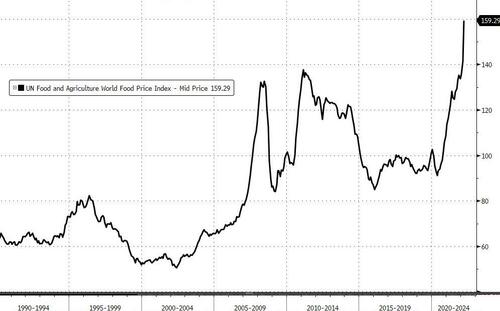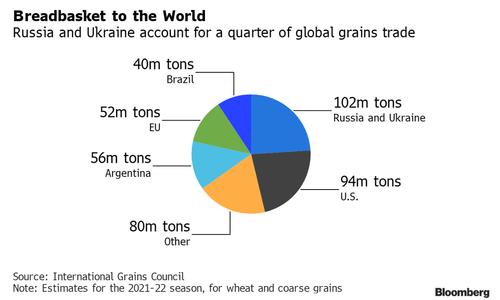Global Food Prices Explode Higher In March As Ukraine Supply Shock Strikes
Global food prices jumped to a new record high, soaring the fastest on record, as the conflict in Ukraine unleashed food supply shocks across the world.
“The current conflict between Ukraine and the Russian Federation is increasing the risk of a further deterioration of the food insecurity situation at global level,” the FAO said in a recent food insecurity assessment (pdf).
March’s food price index from the Food and Agriculture Organization of the United Nations (FAO) printed 159.3 points in March, up 19.15 points from February, when it had already reached record highs. The index was up 33.6% from the same time last year.
The March rise in food prices is a stunning 12.64% MoM – almost double the previous record monthly surge…
Leading the charge was the FAO Cereal Price Index, up 17.1% in March than in February, entirely driven by significant price increases in wheat and grains as a result of the Black Sea breadbasket region going offline because of the Russian invasion of Ukraine and sanctions-related supply disruptions by Western countries on Russia. The invasion has choked off more than a quarter of the global wheat trade, about a fifth of corn, and 12% of all calories traded globally.
Another driver was FAO Vegetable Oil Price Index, up 23.2%, driven by higher prices of sunflower seed oil, of which Ukraine is the world’s leading exporter. Palm, soy, and rapeseed oil prices increased due to higher sunflower seed oil and Brent crude prices.
It’s not just a shortage of food, but also shortages of fertilizer and skyrocketing diesel prices, the ability to farm and even perhaps produce robust harvests by the end of the Northern Hemisphere growing season could be in jeopardy, which would ultimately extend the global food crisis through 2023.
“Looking forward to 2022-23, we’re already seeing signs that production is going to be reduced in Ukraine,” Erin Collier, an economist at the UN, told Bloomberg.
“The amount they’re able to export really depends on how much longer this conflict continues.”
The bad news is the world’s hunger problem isn’t going away and may only get worse from here…
The risks of soaring basic foods are possible inflation riots in emerging market economies. Last week, the UN pointed out millions of Middle Eastern and North African families struggle to buy even the most basic foods to keep hunger at bay.
“People’s resilience is at a breaking point. This crisis is creating shock waves in the food markets that touch every home in this region. No one is spared,” Corinne Fleischer, UN’s World Food Programme Regional Director said.
The risk of uprisings is increasing by the week as the UN projects food prices to soar even higher. It’s important to note that food prices were already rising before the Ukrainian conflict.
We’ve outlined the most reliant countries on Ukraine wheat, including Egypt, Indonesia, Bangladesh, Pakistan, and Turkey (the countries that could see unrest first).
However, in South America, inflation riots have already begun as the government declared a curfew last weekend. Arab Spring 2.0 appears to be emerging, but this time it could be global, unlike a decade ago.
We are in the early innings of this https://t.co/PPKOq1vDzb
— Doomberg (@DoombergT) April 7, 2022
Tyler Durden
Fri, 04/08/2022 – 18:00
via ZeroHedge News https://ift.tt/0tlTqw2 Tyler Durden


